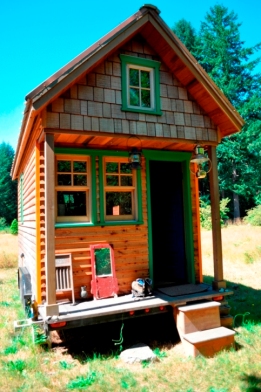I wrote a couple of posts last year about minimalism and change, which is both an old movement/philosophy and a modern craze. I believe it is relevant on a blog about developmental disorders, because it’s not just about removing clutter from our homes. It’s also about making our lives more manageable. We can make things easier for ourselves by removing the things we don’t need.
We have to be practical about this, something they’re trying to in the TV show Tiny House Nation. It’s about couples and families moving into a tiny house, and the host gives the buyers a challenge before moving. It’s usually about scaling down, about how much (or how little) they can bring from the house or apartment they’re moving out of. I like the idea, but we also have to consider the real world, and in the real world my country has an international reputation for targetting “living outside the box-families”. Choosing a different lifestyle can be risky, especially if one or both the parents are foreign citizens (it isn’t necessarily about colour). Norwegians simply don’t understand why anyone would want to live differently. It makes them suspicious. This is what I mean by practical. There are things to consider besides being willing to live with less comfort.
So we have to consider all aspects, but I like the philosophy behind minimalism. A blogger I’m following recently wrote about a TV programme she had seen. It was with Marie Kondo, who basically cleans with Shintoism. She’s apparantly controversial in her own country, Japan, because she’s being accused of using a watered down version of Shintoism. She sees objects as animate, and she believes that these objects, as well as the house itself, want to be useful to us. Her method is to hold everything she owns and ask if this item gives her joy, and if it doesn’t, she gives it away.
Religion is frequently abused and misunderstood, so it may be risky to mix it into everything, but it could still be a good idea. It’s sort of what I have been trying to do in recent years anyway. I ask myself what I get out of it. I used to watch more TV than I do now. It was on most of the time, even though I wasn’t actually watching it that closely. It was so easy, if I was bored, to look for some diversion. I try to be more active now, and I ask myself if that is the best use of my time.
It’s not a bad thing to watch sport if that gives you joy, but I frequently found that it didn’t because I kept thinking of the tings I wanted to do, but never had the drive or energy to get started. I switch between Netflix, music and podcasts on Spotify/iTunes, reading, and writing these days. I’m not perfect of course, and there are days when I don’t feel like doing much. I allow myself an occasional day of apathy and music, but then I remind myself that I should challenge myself.
I could have lived well in a tiny house myself, if they had been legal here (like I said, making a different choice is hard here). I don’t need much as I have downsized my library. I only buy books I know I want to re-read, and I get the rest from the library. It’s the same story with films, because apart from LOFTR, The Hobbit, Star Wars, and Star Trek I get the rest from streaming.
Minimalism is not a law. The whole point is that there isn’t a national or international standard you have to meet. I haven’t really done it before, but thinking in religious terms may be useful. I don’t know if any religion allows you to pursue money. That doesn’t mean that having money is a bad thing, but to continue pursuing it after you are rich probably isn’t conducive to a spiritual lifestyle. The way the stock market works is that corporations are being punished if their profit is slightly lower than expected. It has always puzzled me how a stock goes down because the market wanted more. That’s how it is constantly pursuing money, you’ll never be satisfied.
You can have money and still choose a minimalist liestyle, which will enable you to spend it on someone else. That would be a spiritual lifestyle no matter what religion you belonged to. I believe some do because it’s more relaxed lifestyle. So I’d like to ask myself questions like: Does the item have a purpose, does it make it easier ot harder for me to connect to God and the people around me, does it make it harder or easier to reach my goal of becoming an author, does it make me less or more healthy? In short, does it improve lives?
Besides, we are just here for a short period anyway, 90 years or a little more if we are fortunate. The things we think we own are just borrowed, we have to return them. They belong to God (or the universe), and like my fellow blogger, I might ask God how he wants me to use these objects.
The posts I referred to in the introduction are Minimalism: The new elitist lifestyle, Finding the old me, We need something new.
The photos are from a museum in my hometown. It’s from a collection of houses showing how people lived there from the 1860 ‘s to the 1950’s. I suscpect this interior shows the end of that period, and the point isn’t that I want to go back to a life without technology, but in some ways life may have been less complicated back then. It’s probably better now, but still, quite confusing.



